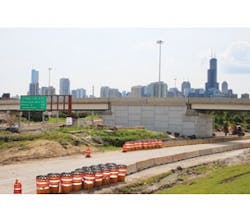They needed a weekend to think it over.
In preparation for the demolition of the Ontario Street ramp, which spanned the Kennedy Expressway (I-90/94) in Chicago, prime contractor Paschen and subcontractor Omega Demolition were bracing for a series of separate closures on one of the most prime pieces of interstate real estate in the entire Midwest. In upwards of 300,000 motorists gather on the Kennedy on a daily basis, a strong percentage being freight trucks moving commerce around the city, and the Illinois DOT (IDOT) would allow work to be done over the course of three weekends starting at 10 p.m. on Friday and ending by 5 a.m. the following Monday. The Ontario Street ramp was divided into three sections for the demolition—units 1, 2 and 3. Unit 2, which hung over the reversible express lanes, was the first to be attacked on June 13, and by midnight on Saturday one of the biggest challenges of the project was figured out.
The existing Ontario Street ramp and the new ramp, which was completed in the spring, were separated by just a couple of feet. Nobody was sure where the debris from the demolition exercise was going to end up, putting the recently completed span in harm’s way. After some thought, it was decided to start chipping away at the parapet wall on the west side of the existing ramp. Work happened so fast Omega Demolition decided to take on unit 3, which was the ramp that took traffic from eastbound I-90/94 to Ohio Street. By 5 a.m. on Monday, June 15, two-thirds of the total project breakdown was complete, and an entire weekend was wiped off the schedule. Shutting down a portion of a major interstate had never been done before in Chicago, and all those involved in this project were only encouraging the feat to be repeated in the future.
“They realized that they were going so fast that they asked IDOT if they also could do unit 3,” Rene Bermudez, resident engineer for IDOT, told Roads & Bridges. “They started that work at midnight on Saturday and they were able to finish Monday morning. It was actually better for traffic because instead of closing down and doing this work in three shutdowns we were able to do it in two weekends.”
On, off and on again
The original Ontario Street ramp was a cast-in-place concrete box girder, and according to Bermudez it was holding up pretty well, but there were some areas of concern.
“When you would go underneath the structure it was certainly falling apart,” he said. “You could see some spots where pieces of concrete had come off, and you could see the reinforcing steel, but you still thought it could last for a few more years.”
Funding became available, so IDOT decided the time was right for a new span over the Kennedy Expressway. The contractor had the option to use self-propelled modular transporters to assist with the demolition, but Omega came with experience when it involved working in the trenches of traffic—the subcontractor just came off a job in southern Illinois where it closed the mainline for a cast-in-place concrete box girder bridge tear down, and was confident the maneuver could work in Chicago. As many as eight Caterpillar excavators with hydraulic hammers showed up for work on the Ontario Street demo site for the 10 p.m. shift on June 13. All seven lanes (five mainline and two express) were blocked off. Beginning at Diversey, lanes were reduced to two and motorists travelled around the work by exiting on eastbound Ohio Street and using temporary pavement to get back on I-90/94. One lane was shut down in the westbound direction, leaving four lanes open. Originally IDOT was going to have trucks haul away the debris one load at a time, but crews were able to use a storage area located adjacent to I-90/94 and the Ohio Street exit. A Caterpillar skid-steer loader was able to push the material over, which saved a considerable amount of time. According to Bermudez, the only task that ate into the schedule involved covering the express-lane gates to shield them from the falling concrete. Crane mats and steel plates were used for protection, and the operation took about six hours to execute.
Unit 1, the remaining portion of the existing Ontario ramp over I-90/94 westbound, was taken out of commission the following weekend. Five mainline lanes and two express lanes were out of service, and the detour started at Congress Parkway, where traffic was pinched to two lanes and emptied onto the eastbound Ohio Street exit to Orleans before it was looped back to westbound I-90/94. Crews again started work at 10 p.m. on June 20 and had all lanes open by 5 a.m. on June 22. However, absent from the equation was the debris storage area, and trucks had to haul the remains of the bridge, a task that was not complete until noon on Sunday, June 21.
Leading up to the closures the IDOT placed advanced warning signs at the Wisconsin and Indiana borders alerting travelers of what was going to take place in mid-June, and the Illinois Tollway used variable message signs to get the word out on it’s network. Every form of media also notified Chicagoans of the event, and Bermudez was relieved at the outcome.
“I was concerned that traffic would be all the way down to Schaumburg (about 35 miles west of Chicago),” he said. “It was scary, but it never happened.”
Making a C
The project area was still a happening place at press time. Paschen was working on substructure work for the Ramp C bridge, which will run alongside the new Ontario Street Bridge over I-90/94. Crews were building the stone column for the stage two portion of the mechanically stabilized earth wall. The ramp going from Ontario Street to the westbound Kennedy, which actually is a single span precast prestressed concrete deck beam bridge supported by cast-in-place abutment walls, was being rehabilitated. The roof of this tunnel is being replaced, and the tunnel itself will be extended 57 ft to accommodate the new alignment of Ramp C. The vertical clearance of the tunnel will be increased 6 in. for a 15-ft clearance, which meets current standards. R&B



